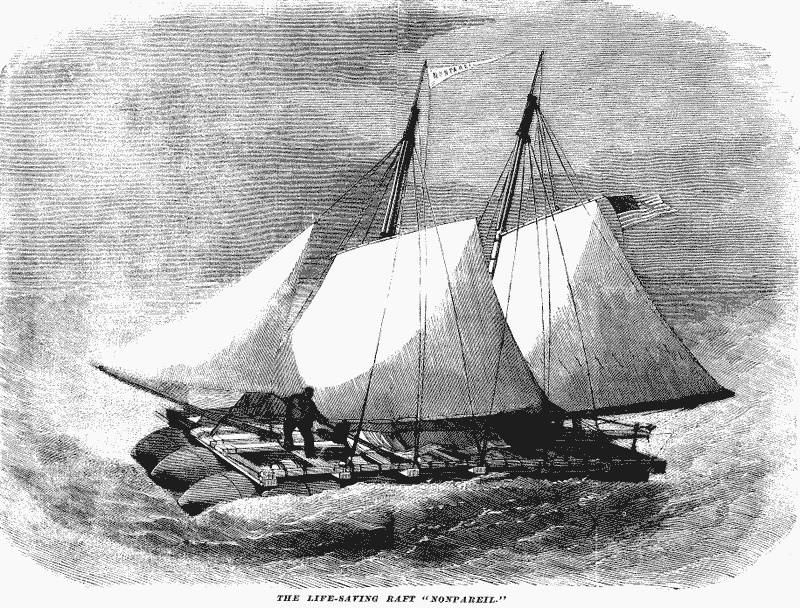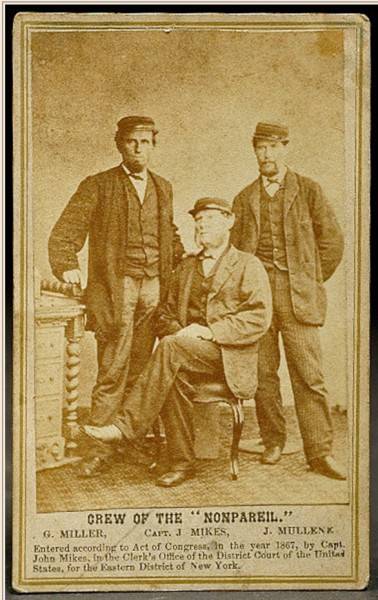"Nonparel" - the predecessor of all modern means of salvation at sea

"Nonparelle" drawing from an American magazine.
We all come from childhood ... And in childhood, each of us dreamed of going on a world tour of the seas and oceans. But the way of transportation was drawn in imagination to each his own. Someone saw himself as a captain of a sailing ship, and someone wanted to swim across the ocean on a raft. As adults, someone was able to fulfill his dream, but for someone she remained unfulfilled.
The raft was and is one of the simplest structures to move on water. On rafts overcame water distances from ancient times. It can be called one of the special examples of “maritime architecture”. After all, the main task of the raft, first of all, the salvation of those in trouble on the water. This is such a kind of first first aid from the sea: until a solid ship saves you, pull drowning people out of the water onto it, dry it on a raft, warm it up, and just keep it up. The design of the raft is extremely simple, just as simple it is in the assembly. But it was just such an inconspicuous building that saved more than one life.

The crew of the raft "Nonparel."
At first glance it may seem that such a simple, easy, uncomplicated ship is unlikely to be able to cover long distances. Not just a big river, but, for example, the ocean. After all, like all sea vessels, the raft is in danger of falling into a storm, a storm, and becoming a toy in huge ocean waves. However, it is not. In the history of navigation there was a case when it was a raft, and a raft made of rubber was able to cross even the Atlantic Ocean.
That's how it was ...
In the distant summer of 1867, a team of three people on the Nonparel (“Incomparable”) raft passed from New York to Southampton in a month and a half. Surprisingly, but a fact: neither the structure itself, nor the crew suffered during the voyage.
Any construction begins with construction. Therefore, it would not be superfluous to tell you about the size of this “vessel”, and how and from what it was built.
By design, it was a raft-trimaran, which was based on inflatable rubber cylinders with pointed ends, which they immediately dubbed "Indian cigars." The length of each “cigar” was 25 feet (7,62 m), diameter - about 2,5 feet (0,762 m). In the middle, the cylinders were connected by a waterproof burlap cover and were tightly tied with ropes to a wooden frame whose length was 21 foot (6, 4 m) and width 12,5 feet (3,81 m). At the bottom there was a device for filling the cylinders with air. A grocery box was firmly attached to the main mast: crackers, canned food, tea, coffee, vegetables - that’s all the simple food that you could take with you in those years. The lid of the box at the same time served as a bed on which two of the crew could fit in (the third at this time was on duty on the watch).
That was the "equipment of the raft." In the middle of it was a small tent made of tarpaulin, in which sailors could hide from the cold wind and splash of water, along the edges of the tent were grooves to collect rainwater. It was the only way to replenish freshwater in transit.
It was on such a raft that three Americans set sail: John Mikey - the captain, George Miller and Jerry Mullen. The raft team decided to prove that the rubber raft is reliable, fast, in short, no worse than a boat, and therefore quite suitable as a life-saving tool on the waters.
Of course, the risk was too great, the Americans understood what adventure they decided on, but what could not be done and what wouldn’t you go in search of the truth!
A few days before sailing to the "Nonparel" loaded food, a fairly large amount of fresh water, which was kept in oak barrels, fur for pumping air in cylinders. In the meantime, the team engaged in loading, on the beach, among the townsfolk, serious passions flared up: no one believed in the safe end of an adventurous journey. Most agreed that the team would definitely die, only the deadlines differed. Who predicted the death of the crew a maximum of a few days, and someone - a few weeks. Excitement embraced all those who were not indifferent to the fate of the team: the stakes were made, the pubs were betting. All and sundry talked about the unreliability of rubber “logs,” that sea water would eat them, and the whole team would go to be eaten by the fish. In general, everyone agreed that the final of this enterprise would inevitably be tragic.
And now it’s 4 June. 1867. Three fearless sailors, escorted by a large crowd of onlookers in New York, set sail and departed from the coast, heading straight east. A light breeze puffed up the sails, and the raft was hesitant at first, but then it began to move more and more confidently beyond the horizon.
As the sailors later recalled, the first few days turned out to be a complete nightmare for them. All this time, the endlessly changing winds (and with it the exhausting bumpiness) and high waves rising in shallow water unfolded the Nonparel seven times to the land (the raft has a very small lateral resistance). It was a time of serious trials, and John Mikey once again thought about whether or not to refuse, before it was too late, this risky venture, from which Providence itself seemed to dissuade him (or maybe Mikey also had such an idea: having arrived back, to the port New York, what words will meet their bewildered crowd? That's just it ...). Recognize yourself as a coward? Well, I do not! Forward and only forward!
Mikey, Miller and Mullen daily and hourly, without dropping their hands, with enviable persistence fought against the drift. Finally, fate took pity on the brave ones. The wind has changed, now it has become a passing one, “Incomparable” has become consistent with its name. The tedious, monotonous bumpkin over the waves ended, and a rubber raft with puffed-up sails dashed to the shores of Britain, to which there were still whole 3000 miles
There was practically no navigation instruments of the Incomparable team. Sailors could only measure the height of the sun at the time of the apogee, and this helped them calculate the geographical latitude and keep the zone of tail winds. That is why the alignment was as follows: they would not miss Europe in any way, and to swim hundreds and hundreds of kilometers across the ocean is just a matter of time ...
Meanwhile, Fortune changed her anger to mercy, and the raft with the brave sailors for a month very well managed to go half way. The supply of drinking water for the team was quite enough. And the food supply was periodically replenished thanks to not indifferent sailors from passing ships. Each crew tried, as it could, to feed the travelers on a raft and in passing wondered if the gentlemen did not want to board the ship and continue their journey in a less exotic way. The crew of the raft amicably refused such kind offers. Products are greatly appreciated. The only thing travelers asked for was to give them only a little whale fat for heating and lighting. Their kerosene, alas, broke down almost immediately after sailing from the port.
In addition to products, they received some gifts. The most unexpected, but very pleasant gift was the chicken, which the team of the ship met on the way gave them. Chicken not eaten. She became the fourth, full-fledged member of the raft team, and traveled along with everyone all the way until she arrived at the port of Southampton. So that the chicken was not carried away by the wave into the ocean, it was tied with a rope by the leg. So she traveled with them, brightening up the monotony and boredom on the raft.
Later, one of the curious visitors, looking around the raft, wondered if the sailors would give way to their own, now legendary, hen. The captain readily agreed to sell the bird for a hundred guineas. The visitor cheered, but did not buy the chicken, saying: "If I had a guarantee that the eggs laid by this chicken would make me as courageous as you, captain, I would not regret it more."
Of course, the journey was not easy. Everyone knows that it is not so easy to overcome the ocean expanses: storm winds, hurricanes, or vice versa, complete calm for several days - is this not a test of endurance, endurance, courage, strength of spirit. And yet fate favored the brave sailors, she took away the deadly danger from them, took care of them. And with the well-being of the team, too, everything was in order. Only the captain felt unimportant a couple of days. But it was the result of too rich dinner with the captain of the oncoming ship, who invited everyone to dine with him.
Swimming was nearing its end. And on Thursday, 25 July, at 4 hours of the afternoon, Nonparelles, in tow, enters the port of Southampton under the star-and-striped flag of his country.
Fearless crew of sailors welcomed all the ships that were at that time in the port. Local newspapers glorified the heroes, and the voyage itself was called the sensation of the year.
Some time later, Captain John Mikey makes an attempt to put up a raft for sale. The captain was hoping for success, as the raft was run in, passed tests by storms, strong salty sea water, powerful blows of the waves. They decided to sell at the industrial fair in Berlin, where, of course, there are more buyers and there is an opportunity to really profitably sell, and it will not be superfluous to show the goods in person (in action). Alas ... The Trimaran never interested anyone.
Later "Nonparel" still sold. What happened next - no one knows. It was rumored that the raft was used as a “water attraction”, that later the raft was worn out and its life ended at a landfill.
The fate of the suddenly famous chicken, too, remained unknown. The fate of the raft team is also unknown. They say that they returned to their native America and each went their separate ways.
Only three years later, a small article appeared in the New York Times that allegedly John Mikey once again decided to “conquer” the Atlantic, that his new “watercraft” now stands in Philadelphia, and Mikey hopes that for the brave sailor to collect the necessary amount for another risky venture. Most likely, the required amount was not collected, because Mikey never set sail.
And after some couple of years a small note about the glorious Nonparel raft, which should be on board any ship, was placed in one of the American magazines.
It will take many more years. But what John Mike's fearless team did, “not for the sake of gain, but for the good of the cause,” bore fruit. Rubber inflatable rafts, as a new life-saving tool has been used everywhere. Mikey’s “brainchild” did not die, it was perfected over the course of several centuries. Until now, the rafts are fighting and watch, and save people, and carry cargo to places where no ship can pass.
And all this “Nonparel”, “Incomparable”, plus three desperate like-minded people, obsessed with one idea and an endless desire to prove to everyone that their “strange raft” (“yes, who needs it!”) Would do a lot for the people and glorify their fatherland.
Information